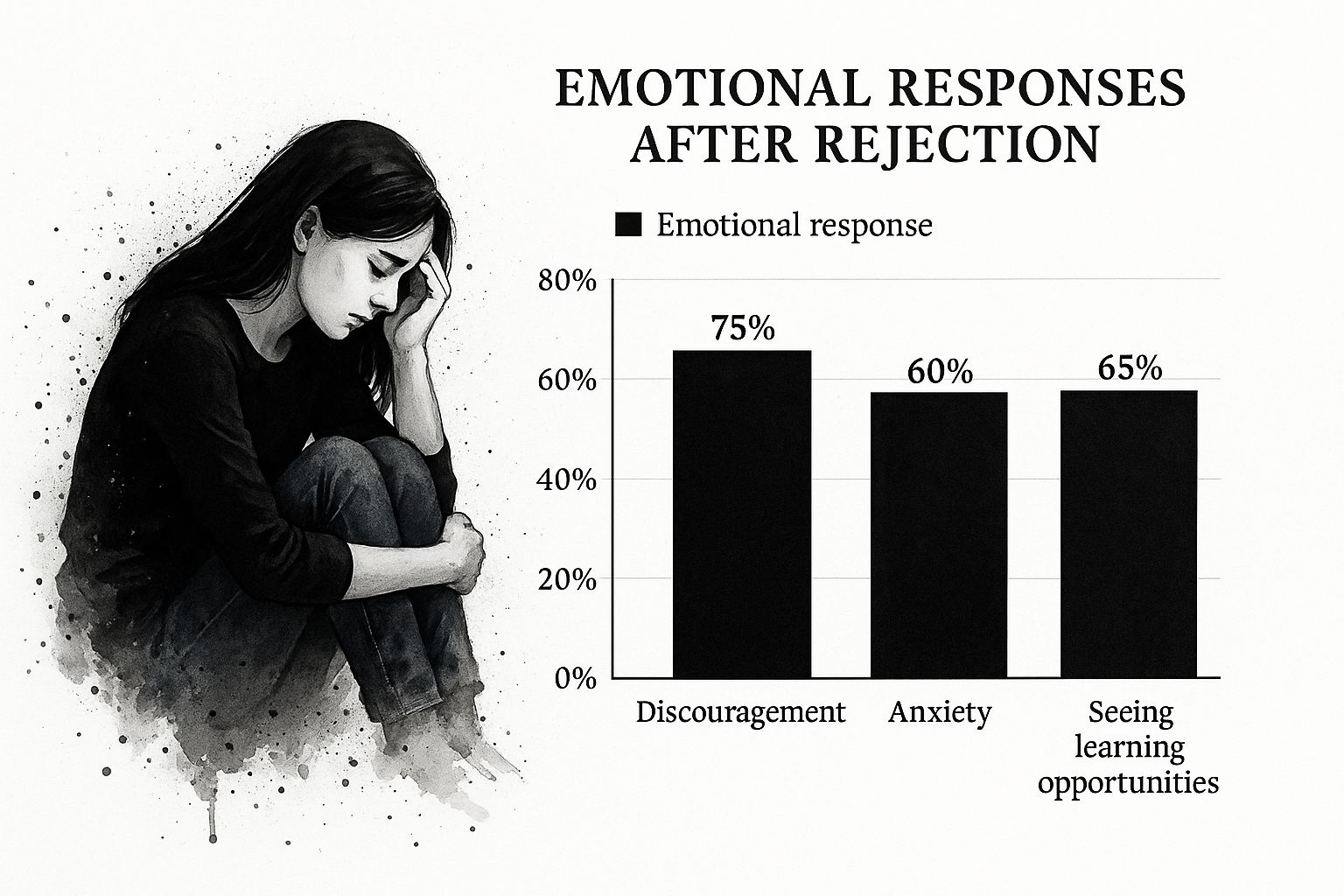Learning how to handle rejection isn't about pretending it doesn't hurt. It's about acknowledging the pain, giving yourself the space to process it without judgment, and then intentionally shifting your focus from blame to understanding.
This reframes the entire experience. It stops being a personal failure and starts becoming an opportunity for real growth. Let's dig into that framework, starting with why it stings so badly in the first place.
Why Rejection Hurts So Much
Let's be real—rejection is brutal. It’s a universal human experience, but knowing you’re not alone doesn’t always soften the blow. The pain is genuine because our brains are literally wired for social connection.
Think about it from a survival standpoint. Historically, being part of a group was essential to stay alive. Getting kicked out of the tribe was a death sentence. So when we feel excluded, our brain can trigger a legitimate threat response. This isn't just you being "too sensitive"; it’s a deep-seated, primal reaction.
When you're turned down for a date, left out by friends, or passed over for a job, your brain can register that emotional pain in the same regions that process physical pain. That’s why it can feel like a punch to the gut. The initial reactions are almost always the same:
- Self-Doubt: You immediately start questioning your worth, replaying the scenario over and over to pinpoint what you did "wrong."
- Frustration or Anger: It's easy to lash out, either at the person who rejected you or by turning that anger inward on yourself.
- Avoidance: You might try to ignore the feeling or pretend it doesn’t bother you, but that just puts off the inevitable and makes it harder to process.
Moving From Reaction To Response
These feelings are totally normal, but the key to handling rejection is learning to move past them. It's all about building resilience, which starts by acknowledging the emotional hit without letting it define who you are.
For instance, if you're trying to figure out why someone you're interested in is suddenly creating distance, understanding common patterns can be a huge help. You can get more insight by learning about the reasons why men pull away in our detailed guide.
The goal isn’t to stop feeling the sting of rejection but to shorten its lifespan. Acknowledge the emotion, analyze the situation with curiosity instead of criticism, and then consciously decide to move forward.
The initial gut reaction is one thing, but the constructive response is what helps you grow. The table below breaks down the difference between common knee-jerk reactions and the more mindful responses you can cultivate.
Common Reactions vs. Constructive Responses to Rejection
| Common Reaction | Constructive Response |
|---|---|
| Immediately blaming yourself. | Acknowledging your feelings without self-judgment. |
| Getting angry or lashing out. | Seeking to understand the situation from all sides. |
| Avoiding the pain or pretending it's fine. | Allowing yourself time to feel and process the disappointment. |
| Making sweeping negative generalizations. | Viewing the rejection as a specific event, not a reflection of your total worth. |
| Isolating yourself from others. | Leaning on your support system for perspective and comfort. |
Shifting from the left column to the right is a conscious choice, and it's where real resilience is built. It's not about being emotionless; it's about being emotionally intelligent.

As you can see, while discouragement is a common and valid response, a significant number of people—65%—are able to reframe rejection as a chance to learn and grow. That's the mindset we're aiming for.
Navigating the First 24 Hours

The moments right after a rejection hit the hardest. Your mind starts racing, your stomach feels like it’s in knots, and you’re hit with a powerful urge to either lash out, hide from the world, or desperately try to fix things.
Here's the secret: your job isn't to suppress those feelings. It’s to create a small buffer between that initial sting and whatever you do next.
Instead of obsessing over what went wrong or trying to win them back, your only task in these first few hours is to give yourself some breathing room. The idea is to just ride out that first emotional wave without making any sudden moves you might kick yourself for later. This pause is your first real step toward building resilience.
Create Immediate Emotional Space
Whether you've just been passed over for a promotion or told there won't be a second date, your nervous system is on high alert. The absolute best thing you can do is physically and mentally step away from the source of the pain. This isn't about avoidance; it's a strategic retreat to let your body’s stress response calm down.
Let's say you just got a rejection email that stings. Instead of reading it over and over or firing back an impulsive reply, just close the laptop. Your first move should always be to change your scenery and give your brain something else to focus on, even if it's just for a few minutes.
Here are a few simple, real-world ways to create that space:
- Take a walk, but leave your phone behind. Just focus on the feeling of your feet on the pavement, the air, the sounds around you. The goal here is to break that obsessive mental loop and reconnect with the physical world.
- Journal your raw thoughts. Grab a notebook and write down everything you're feeling, completely unfiltered. Getting the chaos out of your head and onto a page makes it feel so much more manageable.
- Call a friend who's a good listener. Reach out to someone you trust to just listen, not to offer a million solutions. Just saying the words out loud can take the edge off and remind you that you're not alone in this.
Resist Unhealthy Impulses
During this first day, your brain will probably throw some unhelpful coping mechanisms at you in an attempt to protect your ego. Recognizing these impulses for what they are is the first step in not giving in to them.
One of the biggest traps is seeking a quick shot of external validation. This could look like posting a selfie just to get a flood of likes or texting an ex hoping for a quick confidence boost. It feels good for a second, but it rarely works long-term.
Resisting the urge to immediately react is a form of self-respect. It communicates to yourself that your emotional wellbeing is more important than a quick fix or an impulsive response.
That kind of temporary validation is like putting a band-aid on a deep cut—it often just leaves you feeling worse later. Instead, try to focus on self-soothing activities that don't rely on anyone else's approval. Building this foundation allows you to come back and learn from the experience later, once the initial sting has faded.
Shifting from Self-Blame to Self-Awareness

Once the initial sting of rejection fades, it’s all too easy to fall into a spiral of self-blame. You find yourself replaying every conversation, every interaction, desperately trying to pinpoint where it all went wrong.
But learning how to handle rejection means learning to separate who you are from what happened. It’s about untangling your sense of self-worth from this one event.
The first move is to challenge those automatic negative thoughts that pop up. Instead of just accepting your inner critic’s harsh judgment, start questioning it with a bit of curiosity. This isn’t about denying the hurt; it’s about figuring out what this experience can teach you about yourself and what you truly need.
Question Your Story
The story you tell yourself about the rejection is infinitely more powerful than the rejection itself. A thought like, "They didn't choose me, so I must not be good enough," feels like a fact, but it's just a story.
Start rewriting that narrative by asking a few simple, powerful questions to get some much-needed perspective:
- What proof do I have that this feeling is wrong? Pull up memories of past wins, times you felt confident, or moments you were proud of yourself.
- Is there another way to see this? Maybe their decision had more to do with their own stuff—their timing, their needs, their issues—than it did with you.
- What can I actually learn from this? Was there a blind spot you discovered? A communication skill you could sharpen for next time?
This shift is crucial. When we take rejection personally, it’s easy to start overthinking every future interaction, which can sabotage potential connections before they even start. Breaking that habit is a game-changer, and learning how to stop overthinking in relationships is a great place to start.
Rejection feels deeply personal, but it’s rarely a complete verdict on your value. It’s just one data point in a lifetime of experiences. Treating it with curiosity instead of judgment is the first step toward building real resilience.
This mindset is just as critical in our professional lives. In the workplace, rejection can sometimes cross a line into harassment or even violence. A global survey revealed that nearly 23% of employees have experienced violence or harassment at work, yet only about half of them ever report it.
You can explore the full UN report to see the data for yourself. By separating your worth from a negative event at work, you're better equipped to handle these tough situations and get the support you need.
Reconnect With What Makes You, You
When a big rejection hits, it can feel like your whole world shrinks. Suddenly, you're questioning everything about yourself, and your confidence is probably shot. The way back isn't to wait for someone else to tell you you're okay; it's about getting back in touch with who you are, completely separate from this one painful moment.
Think of it like this: rejection is a single event, a blip on the radar. Your actual value? That’s the whole damn radar screen. The first real step to handling the sting of rejection is to ground yourself in that reality. This isn’t just about "thinking positive"—it's a practical strategy to get your feet back under you.
Take Stock of Your Wins
Right now, your brain is probably stuck on a loop, replaying the loss. You have to consciously break that cycle and point your attention elsewhere.
Grab a notebook or open a new note on your phone. Start listing things you're genuinely proud of. Don't filter yourself. This isn't a resume; it's for your eyes only. Big wins, small victories, it all goes on the list.
- Finally nailed that tricky recipe you’ve been working on? Write it down.
- Talked a friend through a really tough spot? That absolutely counts.
- Proud of how you navigated a difficult situation at work last year? Add it.
Reading this list is a tangible reminder that your skills, your kindness, and your accomplishments are real and exist completely outside of this one setback.
Rebuilding your self-worth isn't a passive waiting game. It's an active process. You have to cultivate it by remembering your strengths, doing things that make you feel capable, and sticking close to people who see your value clearly.
This becomes even more essential when the rejection you're facing is tangled up in bigger issues, like discrimination. The data is clear: mistreatment isn't handed out equally. For example, one study found that 25% of Black women report experiencing discrimination at work, a figure significantly higher than the 11% reported by white men.
Numbers like these are a powerful reminder that rejection often has far more to do with someone else's biases than any personal failing. Understanding this can help you take it less personally and treat yourself with the compassion you deserve. You can dig deeper into these workplace dynamics in the full study.
Turn Rejection Into a Catalyst for Growth

Once the initial sting of rejection fades, you're left with a powerful opportunity. It's not just about healing—it's about using the experience to sharpen your focus and move forward with a clearer sense of purpose. Every setback is a chance to build resilience and get real about what you truly want.
This means looking for patterns, not to place blame, but to gain insight. Are there common threads in your experiences? Honest self-reflection can spotlight areas you might want to work on, whether that’s improving your communication skills or making sure your actions line up with your long-term goals.
Refine Your Approach
Learning to handle rejection well is all about turning it into actionable feedback. Maybe that job interview that went sideways showed you a need to practice articulating your strengths. Or maybe a romantic rejection made you realize you weren't being upfront about your expectations.
It’s a process that feels a lot like overcoming a creative slump. In the same way that learning how to overcome writer's block demands new strategies and a fresh perspective, dealing with rejection pushes you to look inward and adjust your method.
The most powerful takeaway from any rejection is the reinforcement of your own self-worth. It’s a chance to prove to yourself that your value isn’t determined by external validation but by your ability to get back up.
It's also important to remember that rejection isn't always personal. Systemic issues often play a role. For instance, 45% of American workers report facing discrimination at work, a widespread form of rejection that has nothing to do with an individual's worth. Keeping these broader factors in mind can help you depersonalize the experience and focus on what you can actually control.
Ultimately, each time you face a setback, you're building the emotional muscle to not just survive the next one, but to see it for what it is: an unavoidable part of a rich, meaningful life.
And if you're dealing specifically with a romantic rejection, our guide on the 8 essential breakup recovery tips for healing offers more focused advice to help you through it.
Got Questions? We've Got Answers
Even with the best advice, real-life situations get messy. Let's tackle some of the most common questions that pop up when you're trying to move on from rejection.
How Do I Handle Seeing The Person Who Rejected Me?
This is always awkward, isn't it? The key is to keep it polite, brief, and completely neutral. A simple nod or a quick "hey" as you walk by is more than enough.
Your goal here isn't to restart a conversation or prove you're "over it." It's about showing yourself that you can handle a brief encounter with grace. If you can't avoid talking, keep it short and stick to bland, neutral topics. This whole approach is about protecting your own emotional energy and stopping the awkwardness from spiraling.
The real power move? Get so wrapped up in your own life and goals that their presence barely even registers. When you're genuinely focused on your own growth, seeing them becomes a non-event.
What If I Can't Shake My Feelings For Them?
First off, that's completely normal. Feelings don't come with an off-switch, so don't beat yourself up about it. The first step is just to accept that they're there without any self-judgment.
Give yourself the gift of time and space. Seriously. This might mean muting their social media profiles for a while or steering clear of places you know they hang out. Funnel that energy back into yourself—hit the gym, call up friends you haven't seen in a while, or dive back into a hobby you love. The more you invest in your own happiness, the more those intense feelings will naturally start to fade.
When Is It Time To Talk To A Professional?
If the sadness, anxiety, or feelings of worthlessness stick around for weeks and start messing with your day-to-day life—your job, your sleep, your other relationships—it might be a good time to talk to a professional.
There's absolutely no shame in it. In fact, there's immense strength in asking for help. A therapist can give you specific tools to process the pain and a safe space to work through it. Think of it as a proactive step toward building real emotional resilience. It's the ultimate form of taking care of yourself.
At Poke Match, we're all about giving you expert advice and real-world strategies to build stronger, healthier connections. Discover more insights on navigating relationships and personal growth at poke-match.com.
